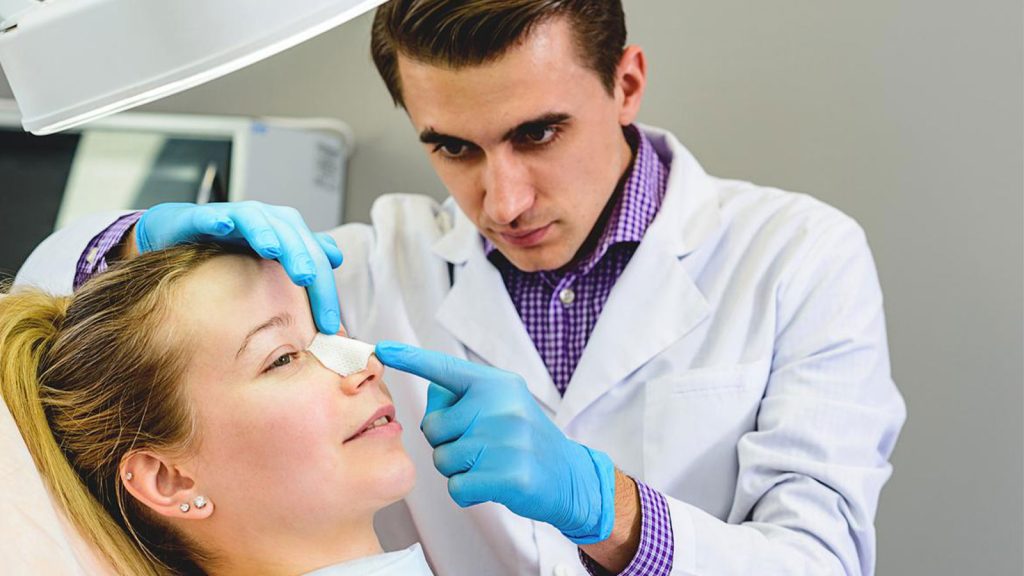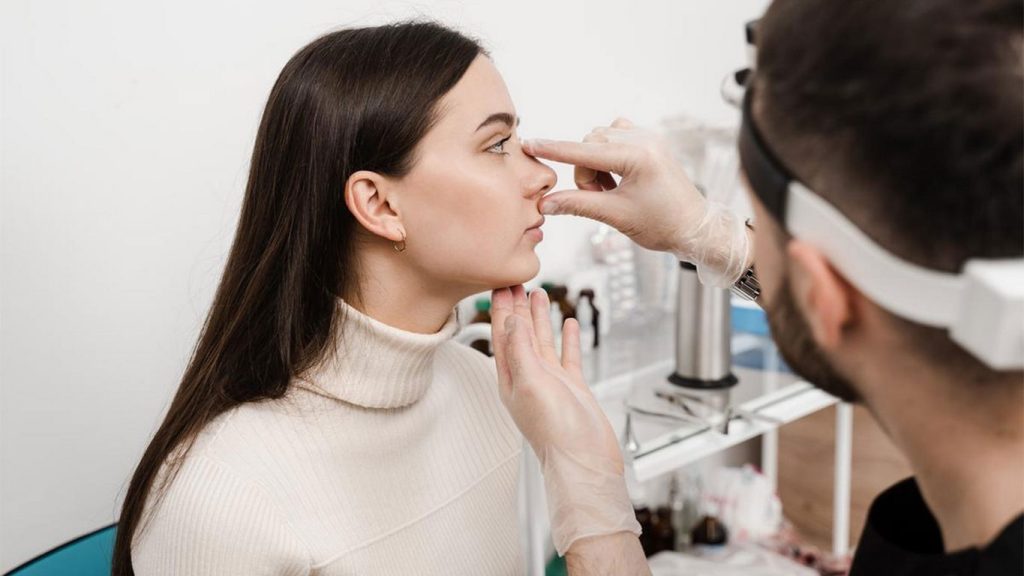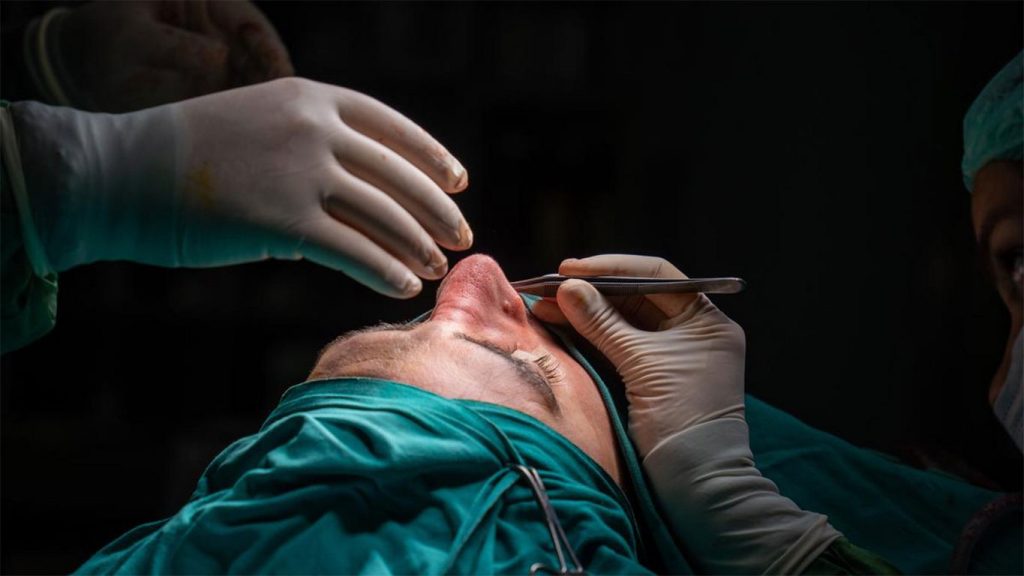Everything you need to know about rhinoplasty
Revision Rhinoplasty is performed to correct unwanted results from the initial surgery. This procedure is for individuals who are dissatisfied with the previous surgery’s outcomes, whether for aesthetic or functional reasons. Revision rhinoplasty is a complex procedure and should be performed by an experienced ENT specialist.
Approximately 15% of people who undergo rhinoplasty require revision surgery each year. Revision rhinoplasty has its own complexities, making thorough preoperative evaluation and surgical planning extremely important.
If you are dissatisfied with your rhinoplasty results and looking for essential information about revision surgery, stay with us in this article on Dr. Benyamin Rahmati’s website.
What is revision rhinoplasty?
Rhinoplasty is one of the most popular cosmetic surgeries. Every year, many people undergo this procedure to enhance facial aesthetics. Since rhinoplasty is a complex surgery, it should always be performed by a skilled and experienced surgeon.

When is the best time for revision rhinoplasty?
If a patient chooses revision rhinoplasty due to unsatisfactory aesthetic results, it’s generally recommended to wait one year. During this time, nasal tissues heal completely, and any scars or issues from the previous surgery become fully apparent. At this point, the surgeon can address excessive internal tissue, excessive scarring, or nasal deviations.
If the patient experiences functional issues such as breathing difficulties, recurrent infections, jaw complications, or septal perforation, the surgeon may consider performing revision surgery earlier. In such cases, revision rhinoplasty may be done 6 to 8 months after the initial procedure.
The best surgeon for revision rhinoplasty
The best surgeon for revision rhinoplasty
A small percentage of patients require revision rhinoplasty due to functional problems (such as breathing difficulties, mucosal damage, or septal deviation) or cosmetic issues (such as nasal tip drooping, elongated nose, or scar tissue formation). It’s important to note that the likelihood of requiring revision surgery is the same whether the initial rhinoplasty was performed using open or closed techniques.
Revision rhinoplasty is even more complex than the initial surgery. If not performed by a highly skilled and experienced surgeon, it may cause further complications. During this procedure, the surgeon typically strengthens the septum, reinforces the nasal cartilage, and may use different implants to correct deformities and restore nasal function and appearance.
What are the types of revision rhinoplasty?
Revision rhinoplasty is usually classified based on the type of corrections needed, the complexity of the surgery, the requirement for tissue or cartilage grafts, and changes to the nasal tip. The four common types of revision rhinoplasty are:
Minor revision rhinoplasty
In this type of revision, the patient is generally satisfied with the initial results and seeks only minor adjustments, such as reshaping the nasal tip, removing a dorsal hump, or correcting drooping. This surgery is less complex and may be performed using open or closed techniques based on the surgeon’s recommendation.
Incomplete revision surgery
In this type of surgery, the goal is to complete the corrections left unfinished during the initial rhinoplasty. Common issues include a remaining dorsal hump or nasal tip deformities that need to be corrected.
Structural revision surgery
This procedure is more complex than the previous two types. The initial surgery has altered multiple parts of the nose, often resulting in both cosmetic and functional problems. Cartilage grafting is usually required, and the open revision rhinoplasty technique is typically preferred.
Deformity revision surgery
This type of revision is for patients who have experienced the worst outcomes from their previous surgery. Excessive tissue removal and cartilage loss have led to both functional and aesthetic deformities. Cartilage grafting and the use of structural grafts are key strategies. This surgery is highly complex and is usually performed as an open procedure.
How is revision rhinoplasty performed?
Revision rhinoplasty typically involves the following stages:
Preoperative evaluations and preparation
A thorough evaluation and analysis of the patient’s condition are crucial before revision rhinoplasty. At this stage, you should share all your expectations with the surgeon. Show the surgeon your pre- and post-operative photos and provide your previous surgical report, which hospitals typically give to patients, to help the surgeon fully understand your situation.
After the consultation, the surgeon proceeds with a physical examination (manual evaluation). Your nose will be assessed for asymmetry, deviation, dorsal hump, and cartilage weakness. Most of the issues reported by patients undergoing revision surgery usually involve the lower third of the nose, including the tip, septum, and nostrils.

Revision rhinoplasty in the operating room
After reviewing tests, photos, and nasal condition, the surgical plan and technique are determined. The first step is selecting the type of anesthesia. Similar to primary rhinoplasty, your preference, the surgeon’s recommendation, and the expected surgery duration will determine whether local or general anesthesia and specific medications are used.

Following the physical exam, an internal nasal examination is performed using a nasal speculum. This tool helps assess breathing issues, nasal valve damage, and mucosal condition. After the evaluation, complete blood tests are required. You must inform the surgeon about any medications you take or underlying conditions (such as asthma, allergies, or heart problems). Similar to primary surgery, consultations with anesthesiologists, pulmonologists, and other specialists are necessary. Many surgeons believe that the psychological aspect is the most challenging part of revision rhinoplasty, as patients often feel disappointed with their previous surgery. Therefore, psychological counseling is recommended before undergoing revision surgery
After anesthesia, the surgeon makes targeted incisions on your nose based on the initial evaluation and chosen strategy. As mentioned, revision rhinoplasty can be performed using either the open or closed technique. The surgeon should be aware of previous incision sites. Once the incisions are made, the corrective work begins. Depending on the type of revision, procedures such as tip refinement, hump removal, cartilage grafting, and others are performed. Typically, the corrections are done from top to bottom to achieve the desired result.
Once the necessary corrections are completed, the incisions are sutured, and your nose is bandaged and placed in a cast. The cast remains on the nose for about seven days and is then removed by the surgeon.
Postoperative care after revision rhinoplasty
Postoperative care after revision rhinoplasty is very similar to that of the primary surgery, and during recovery, you should follow these instructions:
- Take prescribed painkillers and antibiotics after surgery.
- Clean the surgical site with hydrogen peroxide as instructed.
- Avoid swimming pools, saunas, and jacuzzis for 6 weeks.
- If the surgeon has prescribed plastic splints or molds, be sure to use them.
- Attend all scheduled follow-up appointments. Full healing and achieving the final results can take up to one year, during which you should remain under the surgeon's supervision.
Rhinoplasty is a multifaceted surgery. Surgeon error, misdiagnosis, changes in the patient’s anatomy, excessive tissue removal (cartilage or bone), poor patient adaptation, or infection are all factors that can affect the outcome of the initial surgery. When such issues arise, revision rhinoplasty becomes necessary.
Revision rhinoplasty is more complex than primary surgery, and the chance of achieving the desired results is about 60%. Therefore, selecting a highly skilled surgeon and medical team is crucial. Dr. Benyamin Rahmati, an experienced ENT specialist with an excellent track record in rhinoplasty, can be a great choice for achieving your ideal nasal shape.



